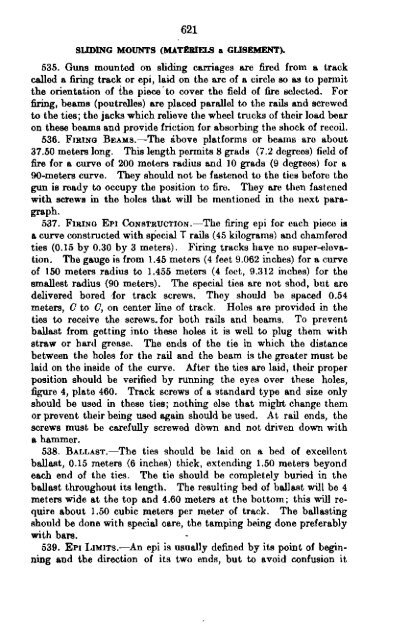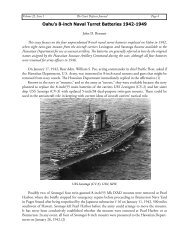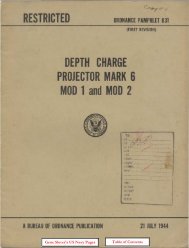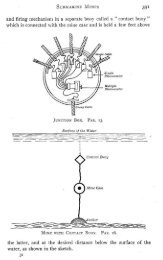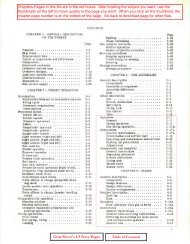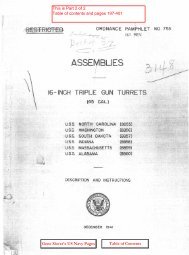...Railway artillery - Personal Page of GENE SLOVER
...Railway artillery - Personal Page of GENE SLOVER
...Railway artillery - Personal Page of GENE SLOVER
You also want an ePaper? Increase the reach of your titles
YUMPU automatically turns print PDFs into web optimized ePapers that Google loves.
621<br />
SUDING MOUNTS (MATbIELS a GIJSEMENT).<br />
535. Guns mounted on sliding carriages are fired from a track<br />
called a firing track or epi, laid on the arc <strong>of</strong> a circle so as to permit<br />
the orientation <strong>of</strong> the piece' to cover the field <strong>of</strong> fire selected. For<br />
firing, beams (poutrelles) are placed pa.ra.llel to the rails and screwed<br />
to the ties; the jacks which relieve the wheel trucks <strong>of</strong> their load bear<br />
on these beams and provide friction for absorbing the shock <strong>of</strong> recoil.<br />
536. FIRING BEAMs.-The above platfonns or beams are about<br />
37.50 meters long. This length permits 8 grads (7.2 degrees) field <strong>of</strong><br />
fire for a curve <strong>of</strong> 200 meters radius and 10 grads (9 "degrees) for a<br />
9O-meters curve. They should not be fastened to the ties before the<br />
gun is ready to occupy the position to fire. They are then fastened<br />
with screws in the holes that will be mentioned in the next paragraph.<br />
537. FmING EPI CoN8TRUOTION.-The firing epi for each piece is<br />
A curve constructed with sPecial Trails (45 kilograms) and chamfered<br />
ties (0.15 by 0.30 by 3 meters). Firing tracks ha,:e no super-elevation.<br />
The gauge is from 1.45 meters (4 feet 9.062 inches) for a curve<br />
<strong>of</strong> 150 meters radius to 1.455 meters (4 feet, 9.312 inches) for the<br />
smallest radius (90 meters). The special ties are not shod, but are<br />
delivered bored ·for track screws. 'They should be spaced 0.54<br />
meters, 0 to 0, on center line <strong>of</strong> track. Holes are provided in the<br />
ties to receive the screws. for both rails and beams. To prevent<br />
ballast from getting into these holes it is well to plug them with<br />
straw or hard grease. The ends <strong>of</strong> the tie in which the distance<br />
between the holes for the rail and the beam is the greater must be<br />
laid on the inside <strong>of</strong> the curve. .After the ties are laid, their proper<br />
position should be verified by running the eyes over these holes,<br />
figure 4, plate 460. Track screws <strong>of</strong> a standard type and size only<br />
should be used in these ties; nothing else that might change them<br />
or prevent their being used again should be used. At rail ends, the<br />
screws must be carefully screwed down and not driven down with<br />
a hammer.<br />
538. BALLA8T.-The ties should be laid on a bed <strong>of</strong> excellent<br />
ballast, 0.15 meters (6 inches) thick, extending 1.50 meters beyond<br />
each end <strong>of</strong> the ties. The tie should be completely buried in the<br />
ballast throughout its length. The resulting bed <strong>of</strong> ballast will be 4<br />
meters wide at the top and 4.60 meters at the bottom; this will require<br />
about 1.50 cubic meters per meter <strong>of</strong> track. The ballasting<br />
should be done with special care, the tamping being done preferably<br />
with bars.<br />
539. EPI LIMITS.-An epi is usually defined by its point <strong>of</strong> beginning<br />
and the direction <strong>of</strong> its two ends, but to avoid confusion it<br />
Digitized by Coogle


